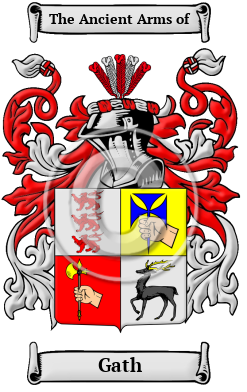| ![Show Contents]() Gath History, Family Crest & Coats of Arms Gath History, Family Crest & Coats of Arms
- Origins Available:
Ireland
Etymology of GathWhat does the name Gath mean? All Irish surnames have underlying meanings that can be traced back to their fullest points when the names first appeared in a Gaelic form. The name Gath originally appeared in Gaelic as Mac Graith or Mag Raith; these are both derived from the personal name Craith which literally means "to weave" and in this case is an occupational name too. The Mac or Mc prefix would denote "son of the weaver." (O'Hart) Anciently the family claim descent through O'Sullivan Mor which explains the stag (or antelope) in the fourth quarter of the shield. In turn, the O'Sullivans descend from the Heber line of Irish kings. (O'Hart) Early Origins of the Gath familyThe surname Gath was first found in County Clare (Irish: An Clár) located on the west coast of Ireland in the province of Munster, where they held a family seat from ancient times. They were the hereditary poets to the O'Briens of Thomond. The family is still found here, but present day descendants usually hail from Tipperary and Waterford. Another branch was located at Termon MacGrath on the borders of Donegal and Fermanagh. 1 The MacGraths were Chiefs in the County of Waterford since very early times. A sub-branch was located at Ballynagilty in Waterford where Philip MacGrath was the progenitor. (O'Hart) This latter branch of the family produced Thomas McGrath of Ardagh, near Youhal, co. Cork who had four sons and twelve daughters. Thomas was descended from the Ulster M'Graths of Clanaboy, who were of the race of Clan Colla and were men of influence in County Waterford. Two of the sons emigrated to the Americas: Alderman Thomas McGrath of Montreal (died 1864); and Denis MacGrath of New York (died in 1846.) (O'Hart) Early History of the Gath familyThis web page shows only a small excerpt of our Gath research. Another 87 words (6 lines of text) covering the years 1067, 1097, 1172, 1240, 1389, 1395, 1400, 1415, 1421, 1423, 1433, 1450, 1460, 1463, 1523, 1580, 1600, 1622 and 1650 are included under the topic Early Gath History in all our PDF Extended History products and printed products wherever possible. Gath Spelling VariationsThe general population of Ireland, like those of Europe and Britain during the Middle Ages, scribes recorded people's names as they saw fit. As a result, surnames often had many spelling variations. For Gath some of these variations included: MacGrath, MacGraw, MacGrauth, Magrath, Magraw and many more. Early Notables of the Gath familyMiler MacGrath (1523-1622), Archbishop of Cashel. Seán mac Ruaidhri Mac Craith (fl. 14th-century), later known as John Macrory Magrath, was an Irish historian known as the author of Caithréim Thoirdhealbhaigh.
Mathghamhain Mág Raith, was Bishop of Killaloe, (1389-1400) and Donatus Mág Raith, O.S.A., was Bishop of Killaloe (1400-1421.) Continuing this line was Thaddaeus Mág Raith I, Bishop of Killaloe (1423-1433) and Thaddaeus Mág Raith II, Bishop of Killaloe, (1460-1463.) Miler Magrath (1523?-1622), was Archbishop of Cashel.
Maolmhuire Mag Raith (Miler Magrath...
Another 80 words (6 lines of text) are included under the topic Early Gath Notables in all our PDF Extended History products and printed products wherever possible.
| Gath migration to the United States | + |
The 18th and 19th centuries saw many Irish families immigrate to North America in search of land and opportunities. The largest influx of Irish immigrants to the United States and British North America came during the 1840s when the Great Potato Famine laid waste to their homeland. Hundreds of thousands left the island in an attempt to escape the starvation and disease it brought. Although the arrival of such a large number of destitute Irish was not welcomed by the established population in the United States and what would become known as Canada at the time, these Irish were an essential element to the rapid development of these growing industrial nations. They filled the demand for the cheap labor needed for the work in factories and in the construction of bridges, roads, canals, and railways. An examination of passenger and immigration lists has revealed many immigrants bearing the name of Gath or one of its variants:
Gath Settlers in United States in the 17th Century- Ralph Gath, who landed in Maryland in 1665 2
Gath Settlers in United States in the 19th Century- Hans Gath, who arrived in Pennsylvania in 1803 2
- Henry Gath, aged 27, who landed in Missouri in 1845 2
- Marie Kath Gath, who arrived in America in 1853 2
- Herm Gath, aged 2, who arrived in New York in 1862 2
- Johann Gath, aged 9, who landed in New York in 1862 2
- ... (More are available in all our PDF Extended History products and printed products wherever possible.)
| Contemporary Notables of the name Gath (post 1700) | + |
- Arnold C. Gath, American Republican politician, Mayor of Tonawanda, New York, 1952-53 3
- MacLysaght, Edward, Irish Families Their Names, Arms and Origins 4th Edition. Dublin: Irish Academic, 1982. Print. (ISBN 0-7165-2364-7)
- Filby, P. William, Meyer, Mary K., Passenger and immigration lists index : a guide to published arrival records of about 500,000 passengers who came to the United States and Canada in the seventeenth, eighteenth, and nineteenth centuries. 1982-1985 Cumulated Supplements in Four Volumes Detroit, Mich. : Gale Research Co., 1985, Print (ISBN 0-8103-1795-8)
- The Political Graveyard: Alphabetical Name Index. (Retrieved 2015, November 3) . Retrieved from http://politicalgraveyard.com/alpha/index.html
 |

